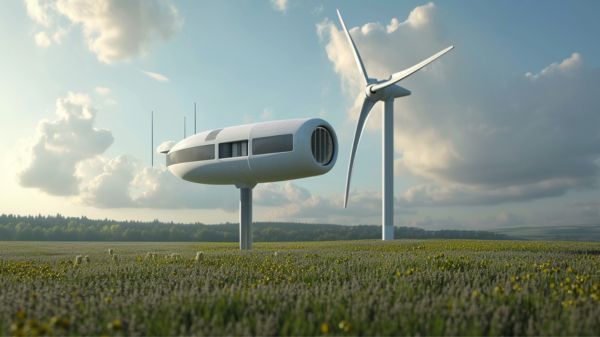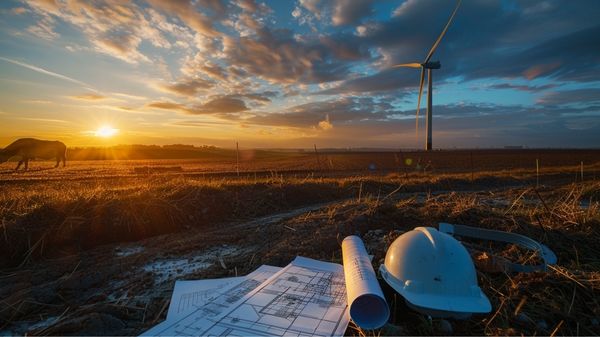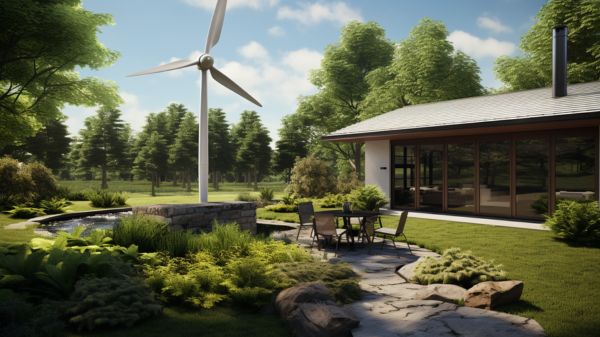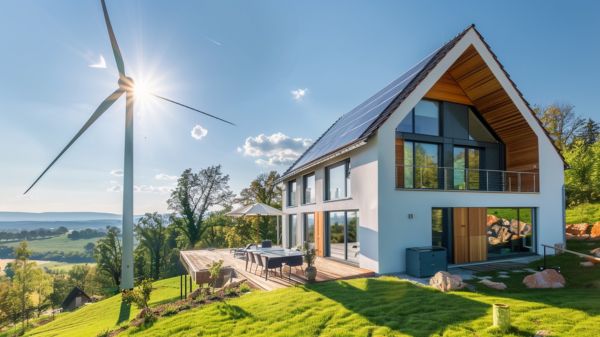As the world increasingly turns to renewable energy sources, wind turbines have become a focal point of technological advancements, offering a glimpse into the potential future of power generation. The latest innovations in wind turbine design and technology, such as enhanced rotor designs and the integration of AI for optimized performance, are pivotal in increasing efficiency and reducing the cost of energy production.
However, the technical complexities and rapid evolution of these systems pose a unique set of challenges for industry professionals and stakeholders. To fully harness these innovative technologies, understanding their underlying principles and potential impacts on the global energy landscape is essential. What remains to be seen is how these advancements will integrate with existing energy infrastructures and what their long-term benefits will be.
Key Takeaways
- Explore advancements in rotor size, which now reach up to 125 meters, enabling greater energy capture and efficiency.
- Investigate Smart Turbine Technologies that utilize sensors and analytics for autonomous operation and predictive maintenance.
- Review the development of Vertical Axis Wind Turbines (VAWTs) for better urban integration and reduced noise levels.
- Learn about Floating Turbines that operate in deeper waters to exploit higher wind velocities and preserve marine environments.
- Examine modular designs in turbines that offer easy transport, quick assembly, and scalable solutions for different environments.
Smart Turbine Technologies
In the domain of wind energy, Smart Turbine Technologies mark a considerable advancement in enhancing both the efficiency and reliability of power generation. These innovative systems integrate sophisticated sensors and advanced analytics to autonomously improve turbine operations.
By continuously analyzing environmental data, these technologies enable real-time adjustments to turbine settings, ensuring ideal energy capture even under fluctuating wind conditions. This capability not only maximizes the operational efficiency of turbines but also greatly increases the overall energy output.
Adding to the sustainability, combining wind and solar technologies further improves energy efficiency, making greenhouses more self-sufficient and less reliant on external power sources.
The core advantage of smart turbine technologies lies in their ability to use data-driven insights for predictive maintenance. This approach proactively identifies potential issues before they escalate, thereby reducing downtime and decreasing the operational costs associated with turbine maintenance.
As a result, the enhanced efficiency and reliability contribute to making wind energy a more viable and competitive renewable energy source.
Rotor Size Enhancements
Rotor Size Enhancements represent a vital evolution in wind turbine technology, greatly increasing the capacity for energy capture. Since the 1990s, rotor diameters have increased from roughly 30 meters to an impressive 125 meters. This growth not only boosts the turbines’ ability to harness wind energy but also considerably impacts overall energy production.
The larger the rotor size, the more wind can be captured, which directly translates into increased energy generation even at lower wind speeds. These advancements are complemented by innovative turbine designs, which not only improve efficiency but also contribute to the overall reduction of carbon emissions by enhancing wind power systems’ integration with the grid.
- Increased Rotor Diameter: Moving from 30 meters to 125 meters enhances the energy capture capabilities of wind turbines.
- Higher Energy Output: Turbines with larger rotors and a power capacity growth from 0.2 MW to 3 MW yield more electricity, optimizing the efficiency of energy production.
- Optimized Turbine Design: Innovations in rotor design, such as the integration of low-specific-power turbines, have streamlined the energy transfer to generators, enhancing turbine performance and durability.
The adoption of larger rotor sizes is essential for the economic viability of wind farms. By accessing stronger winds at higher altitudes and producing energy more consistently, these enhancements in turbine design promise a more sustainable and efficient future in renewable energy technologies.
Vertical Axis Innovations
Vertical Axis Wind Turbines (VAWTs) represent a significant shift in wind energy technology, particularly suited to urban and residential settings where wind directions vary considerably. These turbines are engineered to capture wind from any direction, which contrasts with the fixed orientation of traditional Horizontal Axis Wind Turbines (HAWTs). The inherent flexibility of VAWTs consequently enhances the efficiency of wind energy capture in environments with less predictable wind patterns.
Recent innovations in turbine designs have primarily focused on optimizing VAWT structures to maximize this efficiency. By reducing the number of blades and experimenting with non-traditional shapes, engineers have managed to both cut down on material costs and increase the operational lifespan of the turbines. These design modifications also contribute to a significant reduction in noise production, making VAWTs an even more attractive option for populated areas where noise pollution is a concern.
Furthermore, the ability of VAWTs to integrate into various landscapes without extensive modification makes them versatile tools in the quest for sustainable energy solutions. This adaptability, combined with improved performance metrics, positions Vertical Axis turbines as a pivotal component in the modern renewable energy landscape, driving forward the liberation from traditional energy dependencies.
Additionally, the emphasis on energy independence underscores the growing global movement towards self-sustaining energy practices, further enhancing the appeal of VAWTs in diverse settings.
Advancements in Floating Turbines
Advancements in floating turbines have catalyzed a transformative shift in the domain of offshore wind energy. Unlike their fixed-bottom counterparts, floating wind turbines allow for deployment in deeper waters, opening new horizons in oceanic areas previously deemed unsuitable for wind energy generation.
The flexibility to operate in deep waters is not just a matter of placement but also taps into zones with higher wind velocity, thereby enhancing energy production potential. This is particularly notable as floating turbines contribute to reducing reliance on imported oil, enhancing national energy security by diversifying energy sources.
Key features of these innovative floating turbines include:
- Deeper Water Deployment: Floating turbines can be installed far offshore, in water depths where traditional turbines cannot anchor, expanding the geographical scope for offshore wind farms.
- Enhanced Stability Mechanisms: Utilizing advanced tethered designs, these turbines maintain stability without the need for permanent seabed anchoring, thereby preserving the marine environment and reducing installation complexity.
- Higher Energy Output: By harnessing stronger, more consistent winds available at greater sea depths, floating turbines achieve a notably higher energy production potential, making them a more efficient option in the renewable energy landscape.
With $10.6 million invested in refining this technology and projected cost reductions of up to 50% by 2030, floating wind turbines stand at the forefront of revolutionizing how wind energy is harnessed and utilized globally.
Modular Design and Materials
Innovatively, modular design and materials are transforming the wind turbine industry by streamlining both the construction and maintenance phases. The integration of modular components considerably simplifies the logistics of transportation and assembly. This modularity not only expedites installation but also fundamentally reduces the time and cost associated with these processes.
For instance, the ability to interchange parts swiftly minimizes operational disruptions, thereby enhancing the overall efficiency and productivity of wind farms. Additionally, the application of optimization algorithms in the design process further maximizes the efficiency and adaptability of these modular systems, guaranteeing better performance under varying wind conditions.
Further, the employment of advanced materials such as carbon fiber in blades revolutionizes turbine performance. These materials assure blades are both lighter and stronger, improving aerodynamics and energy capture efficiency. The resultant lightweight structures are easier to handle and install, reducing the structural stress on other turbine components and extending their operational lifespan.
Economically, modular designs facilitate cost-effective repairs and upgrades. This adaptability allows for ongoing enhancements without the need for complete overhauls, thereby maximizing investment over the turbine’s lifecycle.
In addition, the scalability provided by modular concepts allows developers to tailor installations to specific environmental and topographical conditions, assuring peak energy generation tailored to local demands. This strategic flexibility underscores the liberating potential of modular design in fostering adaptive and sustainable energy solutions.
Emerging Challenges and Solutions
As the wind energy sector continues to expand, policymakers frequently encounter significant barriers to its adoption in new regions. Addressing these emerging challenges requires a multifaceted approach, combining technical innovations in wind energy research with strategic policy frameworks.
A vital aspect of fostering broader acceptance is enhancing public awareness of wind energy’s benefits, thereby demystifying its operations and highlighting its role in achieving clean energy goals.
Key solutions include:
- Public Engagement and Education: Initiatives to educate the public about the environmental and economic benefits of wind energy can shift public perception and increase community support.
- Grid Integration Techniques: Developing advanced energy storage solutions and grid management technologies to handle the variability of wind power, ensuring stability and efficiency in energy supply.
- Workforce Development: Establishing extensive training programs to cultivate a skilled workforce capable of supporting the technical demands of the expanding wind energy sector.
These strategies not only address the immediate challenges but also pave the way for sustainable growth and acceptance of wind technologies.
Effective implementation of these solutions will be essential for overcoming the barriers to wind energy adoption and for realizing its full potential in contributing to national and global clean energy targets.
Conclusion
To summarize, the evolution of wind turbine technology showcases significant advancements in smart turbine technologies, rotor size enhancements, and novel vertical axis designs, alongside the development of floating turbines and modular approaches.
These innovations not only optimize energy efficiency but also extend the applicability of wind power in diverse environments. Continued research and development are imperative to overcome existing challenges and further integrate these technologies into the global energy mix, promoting sustainable growth and environmental preservation.




